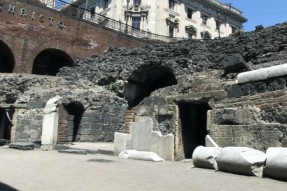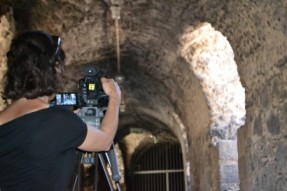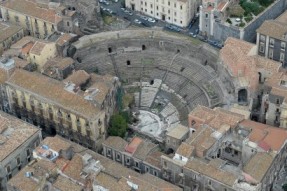Discover Catania: the Roman Amphitheatre [EN]
Archaeology and art blend quite well with the urban setting of Stesichorus Square. The Roman theatre, the eighteenth-century buildings and the liveliness of the historic centre can lead the visitors into a unique journey through the city of Catania (language and voice by Tiziana Balestri)
This is a short film about Catania’s Roman Amphitheatre in Stesichorus Square, involving students from the Laboratory of Communication of Archaeological Heritage for the degree course and training as Tour Operators, offered by the Department of Educational Sciences (University of Catania) and directed by Maria Grazia Branciforti, Dario Palermo and Eleonora Pappalardo who worked alongside Fabrizio Nicoletti from the Greco-Roman Archaeological Site.
Their commitment to the project goes hand in hand with that of the Historical Museum of the Landing in Sicily in 1943, working closely with Zammù TV for technical know-how and field experience. Special thanks to Sonia Giardina, Salvo Noto, Marco Pirrello and Mauro Sodano.
The documentary is the end result of a challenging communication plan for the development and promotion of Catania’s archaeological heritage in the tourist sector. The students made a worthwhile contribution to the draft communication plan deriving from a strong wish to give a higher regard to the monumental heritage of the city.
'Very few people know - explains Eleonora Pappalardo - that Catania is the second-best city in Italy after Rome for the number of Roman monuments. What makes the city's urban area so exceptionally unique in the Mediterranean is the extraordinary relationship between the Roman city and the modern urban structure. The eighteenth-century buildings are the distinctive form of an all-Sicilian variation from mainstream Baroque, thanks to the two-colour combinations achieved with mixed lava stone and limestone, lying right over the archaeological foundations of the city. The historic centre of the Etnean city offers its visitors a unique opportunity to experience the culture in a maze of streets and historic buildings where archaeology and art blend quite well and naturally with the modern urban structure, forming part of an unparalleled travel experience'.
Enjoy this documentary as a more detailed account of the monument through sound and image (language and voice by Tiziana Balestri).
“The greatest evidence of Catania’s ancient grandeur” is the definition given by Prince Biscari. Other eminent names from old times are strongly related to this evidence. Key figures aiming to the art-historical "discovery" of the monument initiated the whole process of excavation and restoration works, overseen by Architect Filadelfo Fichera under the De Felice’s administration in 1904. And as early as 1907 the opening ceremony, with the presence of King Victor Emmanuel III, was held for pursuing this particular objective.
The Roman amphitheatre in Catania, a small portion of which is still visible today, may be regarded as perhaps the most complex of Sicilian amphitheatres, extending itself beneath the Baroque palaces, right between the square and the neighbouring streets. This visible portion includes a section of the north side of the arena, marked off by a podium of rows of blocks. While some of them are covered with marble, some others are covered with what is known as basalt: a dark fine-grained volcanic rock from Etna. On each one of the two sides, are the main axes for a gateway.
Vedi anche
- Unni stai di casa. I racconti del quartiere
- Renato Lombardo: «Fringe Festival, Catania città ideale»
- Arte digitale: a Catania la rassegna “Future Vibes” di Abact
- "Teatri Riflessi", al via la nuova edizione del concorso per corti teatrali
- "Corpi insoliti", teatro tra abilità e disabilità
- La porta delle farfalle, a Librino la più grande scultura di arte contemporanea in bassorilievo ceramico
- Tanti modi di dire teatro
- Aspettando Etnabook 2021
- Diventare Poesia
- Periferie nel centro


